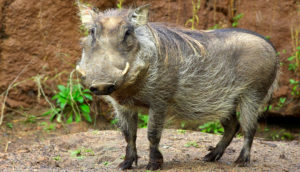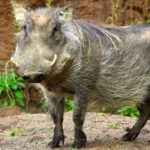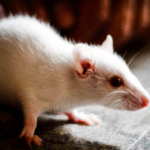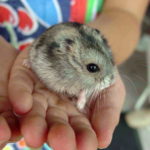Warthogs – information
 Warthogs live in social groups. These groups, as a rule, consist of females and their young, and can include up to 18 individuals. Males usually diverge after 2 years and lead a solitary lifestyle or create bachelor groups. African warthogs are primarily daytime animals and prefer to hide in burrows for the night. For sleep, they use anteater burrows or abandoned dwellings of termites. To cope with high temperatures, warthogs are lying in mud or water, and at low temperatures hide in burrows clinging to each other.
Warthogs live in social groups. These groups, as a rule, consist of females and their young, and can include up to 18 individuals. Males usually diverge after 2 years and lead a solitary lifestyle or create bachelor groups. African warthogs are primarily daytime animals and prefer to hide in burrows for the night. For sleep, they use anteater burrows or abandoned dwellings of termites. To cope with high temperatures, warthogs are lying in mud or water, and at low temperatures hide in burrows clinging to each other.
Warthogs do not exhibit territorial behavior. Different groups of warthogs have large overlapping ranges. They can have common places for rest, feeding and watering. Warthogs are able to change their habitats in response to seasonal water shortages. The area of the range of the African warthog varies from 0.62 square kilometers to 2 3.3 square meters. Km.
Warthogs adhere to the polygamous mating system. Both male and female have many partners. Males, as a rule, do not protect their territory, but during mating periods ritual battles between males are not uncommon. Struggle involves pushing and using the upper blunt fangs to inflict damage on the enemy. The more dangerous lower fangs are rarely used, so serious injuries or casualties are almost non-existent.
Adult males are usually single and join groups of females only for mating. Female attracts wild boars with its hunched look and smell from urination. The periods of mating African warthogs depend on the seasons. As a rule, the estrus in females occurs 4-5 months after the end of the rainy season, and the birth is taught for the dry season.
Warthogs become sexually mature at the age of 18 to 20 months, although males usually do not mate until age 4. African warthogs have the longest period of pregnancy among all members of the family of pigs, from 170 to 175 days. Litters vary from 1 to 7 piglets, an average of 3 piglets in the litter. The piglets are separated from the mother’s milk for about 21 weeks of life. Female African warthogs spend most of their lives in groups, but before giving birth they prefer solitude.



























